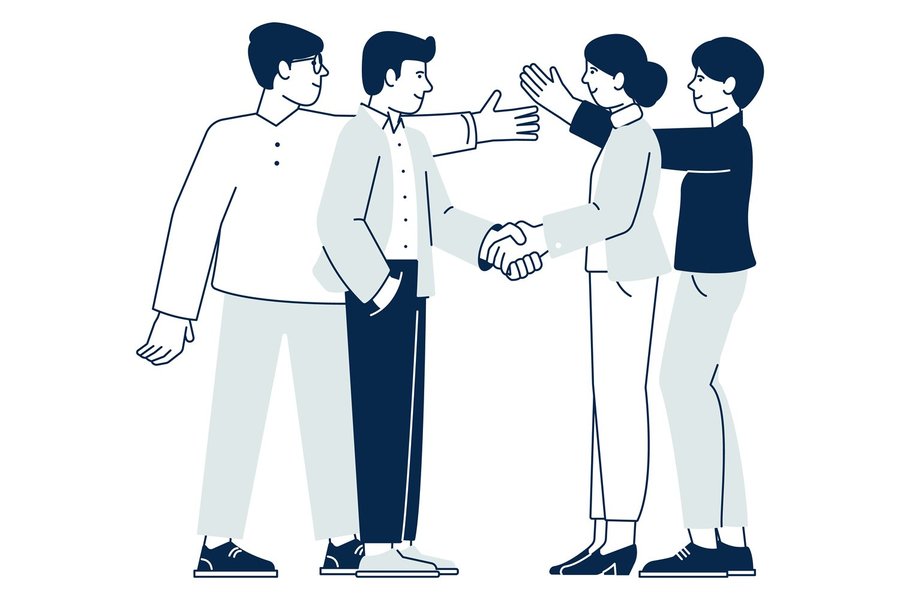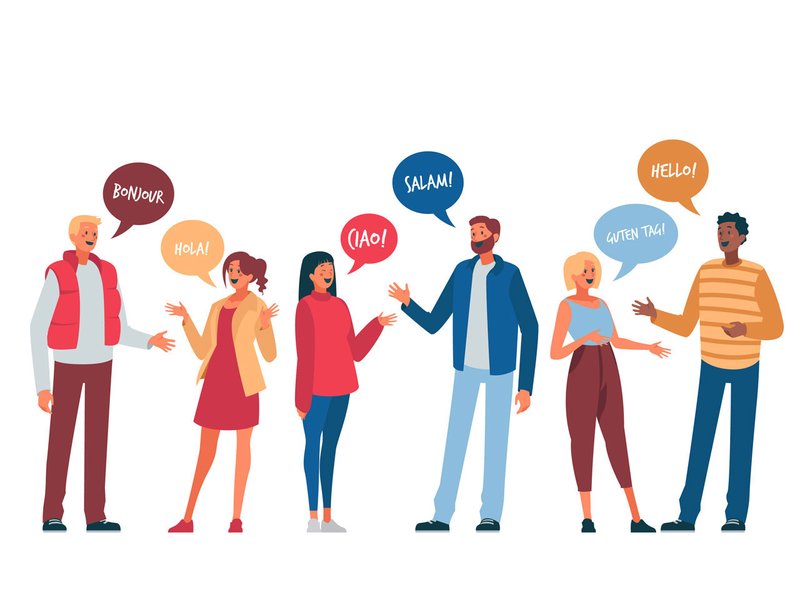
Navigating the Nuances of Greeting and Conversation
Exploring the art of saying hello and sparking engaging discussions in various contexts.
Greetings are fundamental to human interaction, serving as the initial point of connection in both online and offline environments. The simple act of saying "hello" can set the tone for an entire conversation or relationship. However, the appropriateness and effectiveness of a greeting depend heavily on the context, the relationship between the individuals, and the desired level of formality. Understanding these nuances is crucial for making positive first impressions and fostering meaningful exchanges.
Key Takeaways on Greetings and Conversation Starters
- Context is King: The most effective greeting or conversation starter is always tailored to the specific situation and your relationship with the other person. Formal settings require more reserved language, while informal settings allow for more relaxed and casual expressions.
- Authenticity Matters: While knowing various greetings and conversation starters is helpful, being genuine in your interaction is paramount. A sincere "hello" or a thoughtfully chosen question will resonate more than a generic phrase delivered without warmth.
- Beyond the Greeting: A greeting is just the beginning. Following up with relevant questions or comments demonstrates interest and helps to develop the conversation. Active listening and thoughtful responses are key to building rapport.
The Art of the Greeting: Choosing the Right Words
Selecting the appropriate greeting is the first step in any interaction. The English language offers a wide spectrum of options, ranging from highly formal to very casual. The best choice depends on who you are addressing and the setting.
Formal Greetings
In professional or formal settings, it's important to use greetings that convey respect and professionalism. These are suitable for initial interactions, addressing superiors, or in official communications like emails.
Common Formal Greetings:
- "Hello [Name]," or "Dear [Name]," (especially in emails)
- "Good morning/afternoon/evening"
- "How do you do?" (a more traditional formal greeting)
- "Nice to meet you" or "Pleased to meet you" (when meeting someone for the first time)
When using a formal greeting, it's essential to use the person's correct name and title if applicable. For instance, when meeting someone for a job interview online, a greeting like "Hello Ms. Scupi" is appropriate if you know their name.
Informal Greetings
Informal greetings are suitable for friends, family, and in relaxed social settings. They are more casual and can help create a friendly atmosphere.

Common Informal Greetings:
- "Hi" or "Hey"
- "What's up?" or "How's it going?" (often followed by a brief positive answer)
- "Long time no see!" (when you haven't seen someone in a while)
- "Alright?" (a common British informal greeting)
- "Howdy" (common in certain regions of the US)
- "Yo!" (very informal, typically used with close friends)
Using someone's name after an informal greeting can make it more personal, such as "Hi, Monica." Some informal greetings, like "hey," can even be used to initiate a conversation with a stranger in a casual situation, provided they are delivered in a friendly tone.
Greetings in Specific Contexts
The online world presents unique greeting scenarios, from live chat support to online meetings and dating platforms.
Online Greetings:
- Live Chat: Companies often use greetings like "Hi! Welcome to [company name]. If you have questions — feel free to drop me a message." to initiate customer interactions.
- Online Meetings: For a first online meeting, a formal greeting and brief self-introduction are often appropriate. Phrases like "Hi everyone, my name is [your name]" or "Nice to meet you all" are common.
- Online Dating/Meeting Friends Online: The greeting here often depends on the level of prior communication. A simple "hello" might suffice for a first in-person meeting after limited online chat, while a hug could be appropriate if you've been speaking for a long time. The phrase "Nice to e-meet you" is also used when meeting someone virtually for the first time.
When sending emails, the greeting should match your relationship with the recipient. "Hi [Name]," is generally suitable for most circumstances except very formal ones, while "Hello [Name]," is slightly more formal and appropriate for professional emails, even cold outreach.
Beyond the Greeting: Starting a Conversation
Once the initial greeting is exchanged, the next step is often to initiate or continue the conversation. This is where conversation starters come into play. These are questions or comments designed to encourage further discussion and help you get to know the other person better.

Why Use Conversation Starters?
Conversation starters are valuable tools for several reasons:
- Breaking the Ice: They help to overcome initial awkwardness, especially when meeting someone new.
- Building Relationships: They provide a jumping-off point for getting to know someone's interests, thoughts, and experiences.
- Avoiding Small Talk Boredom: Instead of sticking to mundane topics like the weather, conversation starters can lead to more engaging and memorable discussions.
- Demonstrating Interest: Asking thoughtful questions shows that you are interested in the other person.
Types of Conversation Starters
Conversation starters can be categorized in various ways, from lighthearted and fun to deep and thought-provoking.
Examples of Conversation Starters:
- About the Situation: "How did you hear about this event?" or "What do you think of the speaker?"
- About Their Interests: "What are your hobbies?" or "What's the last great book you read/movie you saw?"
- Open-Ended Questions: Questions that require more than a simple "yes" or "no" answer encourage more detailed responses. Examples include "What's something you're passionate about?" or "What's been the highlight of your week?"
- Thought-Provoking Questions: These delve into deeper topics and can lead to more meaningful discussions. Examples include "What's the best question you've ever been asked?" or "What's one thing you would change about the world?"
- Fun and Creative Questions: These are great for casual settings and can inject humor into the conversation. Examples include "If you could have any superpower, what would it be?" or "What's the most embarrassing thing that's happened to you?"
It's often effective to follow up a greeting with a question about the other person's well-being, such as "How are you?" or "How have you been?" While these are common pleasantries, they can also open the door to further conversation depending on the response.
Using Conversation Starters Effectively
Simply asking a question isn't enough; how you use conversation starters matters. Active listening, showing genuine interest in the response, and sharing something about yourself in return are key to a good conversation.

Here are some tips for using conversation starters effectively:
-
Be Prepared: Having a few conversation starters in mind before entering a social situation can boost your confidence.
-
Listen Actively: Pay attention to the other person's response and ask follow-up questions.
-
Share About Yourself: Conversation is a two-way street. Be willing to share your own thoughts and experiences.
-
Read the Room: Pay attention to the other person's body language and interest level. If a topic isn't landing, be prepared to shift to something else.
Putting it into Practice: Examples
Let's consider some examples of how greetings and conversation starters work in different scenarios.
Scenario 1: Meeting a New Colleague
Greeting: "Hello [Colleague's Name], nice to meet you. I'm [Your Name]."
Conversation Starter: "What are your initial impressions of the team/project?" or "How long have you been working here?"
Scenario 2: Bumping into a Friend Unexpectedly
Greeting: "Hey [Friend's Name]! Long time no see! How have you been?"
Conversation Starter: "What have you been up to lately?" or "It's great running into you! Are you free to catch up sometime soon?"
Scenario 3: Initiating Contact on a Professional Networking Site
Greeting: "Dear [Name], I hope this email finds you well. My name is [Your Name], and I came across your profile on [Platform]." (More formal email style)
Conversation Starter: "I was particularly interested in your work on [Specific Project/Area]. Would you be open to connecting and potentially discussing your insights?" or "I'm also working in the [Industry] sector and would love to learn more about your experience at [Company]."
Common Phrases and Their Usage
Here's a table summarizing some common greetings and conversation starters, along with their typical usage and formality level:
| Phrase | Formality | Typical Usage |
|---|---|---|
| Hello | Neutral | General use, can be formal or informal depending on context. |
| Hi / Hey | Informal | Friends, family, casual acquaintances. "Hey" can be used with strangers in casual settings. |
| Good morning/afternoon/evening | Formal/Neutral | Appropriate for most situations, especially in professional settings or when addressing strangers. |
| How are you? / How's it going? / What's up? | Neutral/Informal | Common follow-up to a greeting, can range from a polite pleasantry to a genuine inquiry. |
| Nice to meet you / Pleased to meet you | Formal/Neutral | When meeting someone for the first time. |
| How have you been? | Neutral | When you haven't seen someone in a while. |
| Long time no see! | Informal | When you haven't seen someone in a significant amount of time. |
| What are your thoughts on...? | Neutral | Conversation starter for discussing opinions. |
| Tell me about yourself. | Neutral | Open-ended conversation starter to learn about someone. |
Frequently Asked Questions
Is "How are you?" always a genuine question?
"How are you?" is often used as a polite pleasantry rather than a literal question about your well-being, especially in casual interactions. The expected answer is usually a brief positive response like "Fine, thanks. And you?" or "Good." However, in closer relationships, it can be a genuine inquiry.
How do I greet someone I met online when meeting in person for the first time?
The appropriate greeting depends on the extent of your online interaction. If you've communicated extensively and built a rapport, a hug might be suitable. If you've only exchanged a few messages, a simple "hello" and perhaps a handshake would be more appropriate. It's often best to gauge the situation and follow the other person's lead.
What are some good conversation starters for a group setting?
In a group, you can use conversation starters that invite participation from multiple people. Examples include asking about a shared experience (e.g., "What did everyone think of the presentation?"), a general topic of interest to the group, or a fun icebreaker question that everyone can answer.
How can I make my greetings more memorable?
Adding a personal touch can make your greeting more memorable. This could involve mentioning something specific you remember about the person or the last time you saw them, or using a greeting that reflects your personality while remaining appropriate for the context.
Enhancing Your Conversational Skills
Mastering greetings and conversation starters is an ongoing process. By paying attention to the context, being authentic, and actively engaging with others, you can significantly improve your ability to connect with people and have more rewarding conversations.
This video provides valuable tips on starting conversations effectively.
The ability to initiate and maintain conversation is a valuable social skill. Whether you're aiming for professional networking, building new friendships, or simply having more engaging interactions in your daily life, a thoughtful greeting and a well-chosen conversation starter can make all the difference. Remember that practice and observation are key to becoming a more confident and skilled communicator.
References
Last updated May 5, 2025